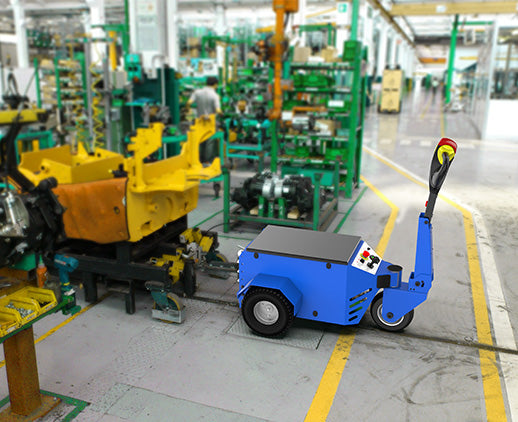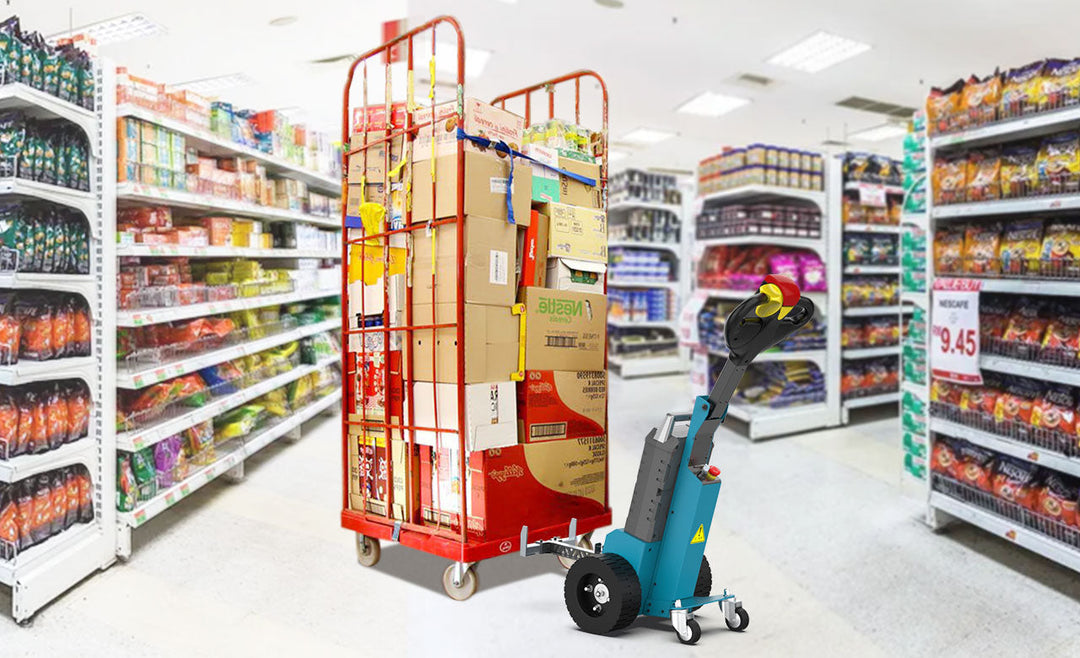Why Switch to a Wireless Controlled Electric Tug

Switching enhances efficiency by 50%, reduces energy costs by 60%-70%, and cuts accident rates by 70%. With intelligent diagnostics, it lowers equipment failure rates by 30% and boosts space utilization by 25%, ensuring safer, faster, and more cost-effective operations.
Increases Operational Efficiency
In ports or warehouse centers, the traditional towing vehicle can handle about 20 containers per hour, while wireless-controlled electric towing vehicles can increase this to 30 containers per hour, improving efficiency by approximately 50%. According to statistics, accidents caused by human operational errors in traditional towing vehicles account for about 15% of total incidents. With wireless-controlled electric towing vehicles, traffic accident rates decrease by 70%.
Industry data indicates that traditional fuel towing vehicles typically consume 2,500–3,000 liters of fuel annually, whereas electric towing vehicles under the same load consume only 1,000–1,500 kilowatt-hours of electricity per year, saving 60%–70% in energy costs. If a company operates 200 towing vehicles annually, the electricity cost for electric towing vehicles is about $200,000 per year, compared to $500,000 for traditional fuel towing vehicles.
The average annual maintenance cost for traditional fuel towing vehicles is $4,000–$6,000, while for electric towing vehicles, it is only $2,000–$3,000. According to data from the Environmental Protection Department, traditional fuel towing vehicles emit approximately 3–5 tons of carbon dioxide annually. The annual reduction in carbon dioxide emissions amounts to about 3,000 tons.
According to an industry report, electric towing vehicles equipped with wireless monitoring systems have a failure rate approximately 30% lower than traditional equipment. It is predicted that by 2025, about 20% of electric towing vehicles globally will feature autonomous driving capabilities.
A company that invested $500,000 in purchasing electric towing vehicles expects to save about $300,000 in energy costs within three years and another $200,000 over five years through reduced maintenance expenses and accident rates, achieving a return rate exceeding 20%.
Reduces Worker Fatigue
Employees operating traditional towing vehicles continuously for eight hours typically experience 10%–15% physical fatigue.
According to corporate survey data, about 30% of employees in warehouses and logistics centers experience fatigue from excessive physical workload during daily tasks. Feedback from some companies indicates that after adopting the equipment, employees' fatigue levels decreased by 35%–50% at the end of their shifts.
Research shows that improved working environments reduce injury rates caused by fatigue or improper posture by approximately 30%. Fatigued employees typically experience a 15%–20% drop in work efficiency. After adopting wireless-controlled electric towing vehicles, efficiency increased by about 25%.
Positions requiring heavy physical labor have a turnover rate approximately 20% higher than other roles. After adopting wireless-controlled electric towing vehicles, employee turnover rates dropped by 10%–15%, and operational errors and collision accidents decreased by 35%.
According to medical research, warehouse operators experience a 15%–20% annual incidence rate of spinal diseases, joint diseases, and muscle injuries due to repetitive labor. In the warehousing and logistics industry, employees under high workloads experience a 25% rate of psychological stress and anxiety. After adopting wireless-controlled electric towing vehicles, overall job satisfaction increased by about 20%.
Improves Load Visibility
Companies using this equipment improve load recognition accuracy by approximately 30%.Employees often rely on visual inspection to assess load conditions, with an error rate of 10%–15%. Using wireless control systems, the error rate is reduced to less than 5%. Research indicates that approximately 20% of logistics accidents are related to improper load assessments. After adopting wireless-controlled electric towing vehicles, accident rates decreased by about 25%.
Data shows that wireless control systems reduce uneven load issues in warehouses by 35%, and equipment failure rates decrease by 20%. Research shows that the failure rate of traditional equipment under overloaded conditions is 40% higher than under standard loads. Maintenance costs are reduced by 15%–20%.
According to surveys, chaotic inventory management in traditional warehouses increases storage costs by more than 30%. Wireless-controlled electric towing vehicles reduce inventory errors by 25% and shorten inventory cycles by 15%. Transport scheduling accuracy improves by 20%.
Research indicates that adopting wireless-controlled electric towing vehicles improves operational efficiency by about 18% and shortens transport times by 10%–15%. Data shows that intelligent load monitoring enhances cold chain logistics quality control by 30%.
Through such optimization, operational costs are reduced by 10%–15%. Data indicates that adopting this system increases customer satisfaction by 20%, while customer complaint rates drop by 25%.
Enhances Workplace Safety
In traditional towing vehicle operations, about 30% of workplace injuries are caused by operational errors or equipment failures.
Using wireless control systems, traffic accidents in warehouses decrease by about 25%. Data shows that safety incidents caused by equipment failures in warehouses decrease by about 30% with this system.Approximately 20% of workplace injuries are related to fatigue and prolonged high-intensity operations. Data shows that during chemical transportation, wireless-controlled electric towing vehicles reduce accident rates by more than 40%.
In multi-vehicle operation environments, traffic accident rates drop by about 35% after adopting wireless-controlled electric towing vehicles. With this system, overload-related accidents during transportation decrease by over 20%, and accidents in warehouses and logistics centers reduce by an average of 25%–30%.
Simplifies Load Handling
According to industry surveys, wireless-controlled electric towing vehicles improve load handling efficiency by about 25%, while reducing warehouse workers' physical exertion by 40%.
Research shows that in scenarios involving the parallel handling of various materials, transport cycles are shortened by 15%–20% with wireless-controlled electric towing vehicles. Errors caused by human handling decrease by about 30%.
Data indicates that after system implementation, accidents caused by uneven or overloaded loads decrease by over 20%. Logistics industry data shows that adopting intelligent scheduling systems improves transport efficiency by about 18%.
Data shows that this system reduces cargo handling time by 20%, while improving transport efficiency per trip by 25%. Cold chain transport industry data shows that wireless-controlled electric towing vehicles reduce cargo damage rates caused by environmental issues during transport by over 30%.
Research data indicates that after adopting wireless-controlled electric towing vehicles, average operating costs decrease by 12%–15%. Data shows that companies implementing wireless control systems experience an 18% increase in employee job satisfaction, along with a productivity growth rate of over 20%.
Works in Tight Spaces
In high-density warehouses and small production workshops, wireless-controlled electric towing vehicles increase space utilization by over 25%. The operational time in narrow aisles is reduced by 20%.
A case study indicates that wireless-controlled electric towing vehicles reduce tasks uncompleted due to space constraints in warehouses by 40%. Data shows that the number of turns during transport processes decreases by 35%.
Data indicates that adopting wireless-controlled electric towing vehicles reduces warehouse damages caused by equipment collisions and space congestion by 30%. Equipment instability caused by uneven loads decreases by about 15%. In certain warehouse environments, downtime and accident times caused by equipment conflicts are reduced by 25%.
Using wireless-controlled electric towing vehicles increases the number of handling tasks completed per unit time by 20%. Data shows that equipment failure rates are reduced by 15%.
Flexible Remote Control
This feature improves overall efficiency in warehouses or production lines by about 20%. Test data indicates that after adopting wireless control, towing vehicle operational errors decrease by about 15%. Statistics show that real-time monitoring systems reduce failure rates by 10%.
In practical applications, logistics transfer efficiency between multiple workshops improves by 18% with wireless control systems. Statistics show that accident rates decrease by over 25% after adopting wireless control systems. Data shows that the multi-functional adaptability of the equipment increases towing vehicle utilization by 15%.
Research shows that with remote control systems, operational coordination among multiple devices improves by 20%, and handoff time between devices decreases by 25%. Statistics show that the simplicity of the operating interface reduces equipment learning and adaptation time by 40%. This intelligent diagnostic feature extends average trouble-free operation time by 12%.












